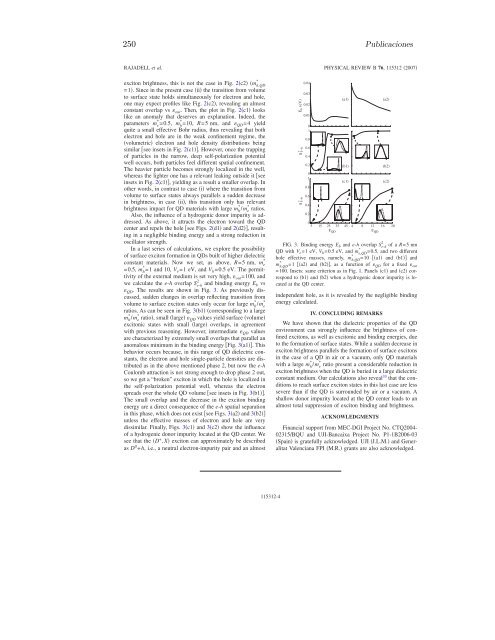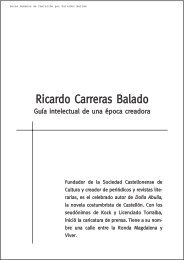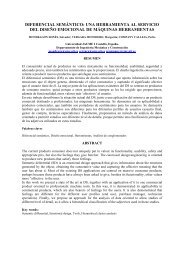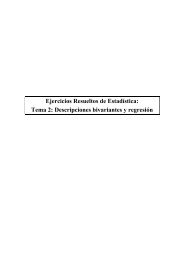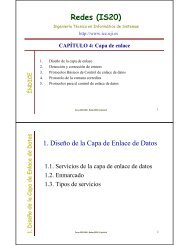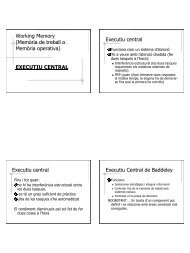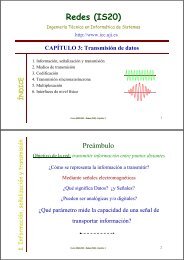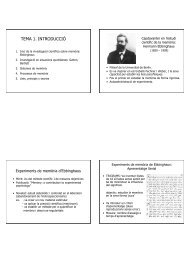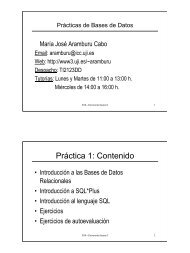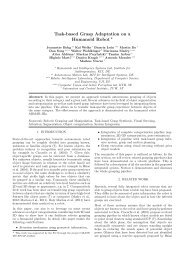250 PublicacionesRAJADELL et al.*exciton brightness, this is not the case in Fig. 2c2 m h,QD=1. Since in the present case ii the transition from volumeto surface state holds simultaneously for electron and hole,one may expect profiles like Fig. 2c2, revealing an almostconstant overlap vs out . Then, the plot in Fig. 2c1 lookslike an anomaly that deserves an explanation. Indeed, theparameters m * e =0.5, m * h =10, R=5 nm, and QD =4 yieldquite a small effective Bohr radius, thus revealing that bothelectron and hole are in the weak confinement regime, thevolumetric electron and hole density distributions beingsimilar see insets in Fig. 2c1. However, once the trappingof particles in the narrow, deep self-polarization potentialwell occurs, both particles feel different spatial confinement.The heavier particle becomes strongly localized in the well,whereas the lighter one has a relevant leaking outside it seeinsets in Fig. 2c1, yielding as a result a smaller overlap. Inother words, in contrast to case i where the transition fromvolume to surface states always parallels a sudden decreasein brightness, in case ii, this transition only has relevantbrightness impact for QD materials with large m * h /m * e ratios.Also, the influence of a hydrogenic donor impurity is addressed.As above, it attracts the electron toward the QDcenter and repels the hole see Figs. 2d1 and 2d2, resultingin a negligible binding energy and a strong reduction inoscillator strength.In a last series of calculations, we explore the possibilityof surface exciton formation in QDs built of higher dielectric*constant materials. Now we set, as above, R=5 nm, m e=0.5, m * h =1 and 10, V e =1 eV, and V h =0.5 eV. The permittivityof the external medium is set very high, out =100, and2we calculate the e-h overlap S e-h and binding energy E b vs QD . The results are shown in Fig. 3. As previously discussed,sudden changes in overlap reflecting transition fromvolume to surface exciton states only occur for large m * *h /m eratios. As can be seen in Fig. 3b1 corresponding to a largem * h /m * e ratio, small large QD values yield surface volumeexcitonic states with small large overlaps, in agreementwith previous reasoning. However, intermediate QD valuesare characterized by extremely small overlaps that parallel ananomalous minimum in the binding energy Fig. 3a1. Thisbehavior occurs because, in this range of QD dielectric constants,the electron and hole single-particle densities are distributedas in the above mentioned phase 2, but now the e-hCoulomb attraction is not strong enough to drop phase 2 out,so we get a “broken” exciton in which the hole is localized inthe self-polarization potential well, whereas the electronspreads over the whole QD volume see insets in Fig. 3b1.The small overlap and the decrease in the exciton bindingenergy are a direct consequence of the e-h spatial separationin this phase, which does not exist see Figs. 3a2 and 3b2unless the effective masses of electron and hole are verydissimilar. Finally, Figs. 3c1 and 3c2 show the influenceof a hydrogenic donor impurity located at the QD center. Wesee that the D + ,X exciton can approximately be describedas D 0 +h, i.e., a neutral electron-impurity pair and an almostE b (eV)S 2 e−hS 2 e−h0.040.030.020.01010.80.60.40.2010.80.60.40.2PHYSICAL REVIEW B 76, 115312 2007(a1)(b1)(c1)05 15 25 35 45 4 8 12 16ε QDε QD2FIG. 3. Binding energy E b and e-h overlap S e-h of a R=5 nm*QD with V e =1 eV, V h =0.5 eV, and m e,QD =0.5, and two different*hole effective masses, namely, m h,QD =10 a1 and b1 and*m h,QD =1 a2 and b2, as a function of QD for a fixed out=100. Insets: same criterion as in Fig. 1. Panels c1 and c2 correspondto b1 and b2 when a hydrogenic donor impurity is locatedat the QD center.independent hole, as it is revealed by the negligible bindingenergy calculated.IV. CONCLUDING REMARKSWe have shown that the dielectric properties of the QDenvironment can strongly influence the brightness of confinedexcitons, as well as excitonic and binding energies, dueto the formation of surface states. While a sudden decrease inexciton brightness parallels the formation of surface excitonsin the case of a QD in air or a vacuum, only QD materialswith a large m h * /m e * ratio present a considerable reduction inexciton brightness when the QD is buried in a large dielectricconstant medium. Our calculations also reveal 33 that the conditionsto reach surface exciton states in this last case are lesssevere than if the QD is surrounded by air or a vacuum. Ashallow donor impurity located at the QD center leads to analmost total suppression of exciton binding and brightness.ACKNOWLEDGM<strong>EN</strong>TSFinancial support from MEC-DGI Project No. CTQ2004-02315/BQU and UJI-Bancaixa Project No. P1-1B2006-03Spain is gratefully acknowledged. UJI J.L.M. and GeneralitatValenciana FPI M.R. grants are also acknowledged.(a2)(b2)(c2)20115312-4
Confinamiento dieléctrico 251THEORY OF DIELECTRICALLY INDUCED SURFACE…*josep.planelles@qfa.uji.es1 A. Zrenner, S. Stufler, P. Ester, S. Michaelis de Vasconcellos, M.Hübner, and M. Bichler, Phys. Status Solidi B 243, 36962006.2 A. D. Yoffe, Advances in Physics Taylor & Francis, London,2001, Vol. 50.3 J. M. Ferreyra and C. R. Proetto, Phys. Rev. B 60, 10672 1999.4 L. E. Brus, J. Chem. Phys. 80, 4403 1984.5 L. E. Brus, J. Chem. Phys. 79, 5566 1983.6 M. Lannoo, C. Delerue, and G. Allan, Phys. Rev. Lett. 74, 34151995.7 P. G. Bolcatto and C. R. Proetto, Phys. Rev. B 59, 12487 1999.8 A. Bagga, P. K. Chattopadhyay, and S. Ghosh, Phys. Rev. B 71,115327 2005.9 A. Franceschetti, A. Williamson, and A. Zunger, J. Phys. Chem.B 104, 3398 2000.10 P. G. Bolcatto and C. R. Proetto, J. Phys.: Condens. Matter 13,319 2001.11 L. Bányai, P. Gilliot, Y. Z. Hu, and S. W. Koch, Phys. Rev. B 45,14136 1992.12 A. Orlandi et al., Semicond. Sci. Technol. 17, 1302 2002.13 J. L. Movilla, J. Planelles, and W. Jaskólski, Phys. Rev. B 73,035305 2006.14 J. Planelles and J. L. Movilla, Phys. Rev. B 73, 235350 2006.15 J. L. Movilla and J. Planelles, Phys. Rev. B 74, 125322 2006.16 V. A. Fonoberov, E. P. Pokatilov, and A. A. Balandin, Phys. Rev.B 66, 085310 2002.17 L. Bányai and S. W. Koch, Semiconductor Quantum Dots WordScientific, Singapore, 1993.18 F. A. Reboredo and A. Zunger, Phys. Rev. B 63, 235314 2001;A. Franceschetti, L. W. Wang, H. Fu, and A. Zunger, ibid. 58,R13367 1998.19 K. Leung and K. B. Whaley, Phys. Rev. B 56, 7455 1997.20 J. L. Movilla and J. Planelles, Comput. Phys. Commun. 170, 1442005.PHYSICAL REVIEW B 76, 115312 200721 F. Stern, Phys. Rev. B 17, 5009 1978.22 J. Climente, J. Planelles, W. Jaskólski, and J. I. Aliaga, J. Phys.:Condens. Matter 15, 3593 2003.23 G. Bastard, Wave Mechanics Applied to Semiconductor HeterostructuresLes Éditions de Physique, Les Ulis, 1988.24 J. P. Loehr, Physics of Strained Quantum Well Lasers KluwerAcademic, Boston, 1998.25 We do not consider any particular QD material, although theseparameters are close to those of SiO 2 .26 The excitonic energy gives us the shift of the optical band gap.The binding energy is calculated by subtracting the excitonicenergy to the ground single-particle electron and hole energies.27 Z. A. Weinberg, J. Appl. Phys. 53, 5052 1982.28 F. Gustini, P. Umari, and P. Pasquarello, Microelectron. Eng. 72,299 2004.29 J. M. Ferreyra and C. R. Proetto, Phys. Rev. B 52, R2309 1995.30 E. F. da Silva, Jr., E. A. de Vasconcelos, B. D. Stošić, J.S.deSousa, G. A. Farias, and V. N. Freire, Mater. Sci. Eng., B 74,188 2000.31 We define binding energy in the presence of a hydrogenic impurityE b D + ,X as in W. Xie, Phys. Lett. A 270, 343 2000, i.e.,E b D + ,X=ED 0 +E h −ED + ,X, where ED + ,X is the energyof the exciton in the doped QD, E h the lowest level of a hole inthe QD without impurity, and ED 0 the ground state of an electronin the doped QD.32 For QD dielectric constants of the order of QD =4, we can onlyget a phase 2 or “broken” exciton if the electron is in an extremelystrong confinement regime that we may get using avery light effective mass while the regime of confinement forthe hole is weak. In such a case, the CI calculations reveal onlytwo phases in which the electron is always volumetric and thehole is either volumetric or facial, depending on out .33 A 5 nm radius QD embedded in an out =100 medium presents asuperficial excitonic ground state if QD 20 m * e =0.5, m * h =10, QD 7 m * e =0.5, m * h =1, and QD 11 m * e =0.2, m * h =2.115312-5
- Page 1:
CONFINAMIENTO NANOSCÓPICO ENESTRUC
- Page 5 and 6:
AgradecimientosDecía Albert Einste
- Page 7:
A mi madreA la memoria de mi padre
- Page 10 and 11:
viiihigh-correlation electronic reg
- Page 12 and 13:
xric) resolution method proves the
- Page 14 and 15:
xii14. F. Rajadell, J.L. Movilla, M
- Page 16 and 17:
xivcen para moldear a voluntad su e
- Page 18 and 19:
xvideterminar las características
- Page 23 and 24:
Capítulo 1Fundamentos teóricosEl
- Page 25 and 26:
1.1 Modelo k · p 3donde p = −i¯
- Page 27 and 28:
1.1 Modelo k · p 5inversa de la ma
- Page 29 and 30:
1.2 Heteroestructuras. Aproximació
- Page 31 and 32:
1.3 Masa efectiva dependiente de la
- Page 33 and 34:
1.4 Aplicación de un campo magnét
- Page 35 and 36:
1.5 Potenciales monopartícula adic
- Page 37 and 38:
1.6 Integración numérica del hami
- Page 39 and 40:
1.7 Transiciones intrabanda 17Tras
- Page 41 and 42:
1.7 Transiciones intrabanda 19g) [7
- Page 43 and 44:
Capítulo 2Confinamientos espacial
- Page 45 and 46:
23esta aproximación asume implíci
- Page 47 and 48:
2.1 Puntos cuánticos de InAs en ma
- Page 49 and 50:
2.1 Puntos cuánticos de InAs en ma
- Page 51 and 52:
2.1 Puntos cuánticos de InAs en ma
- Page 53 and 54:
2.1 Puntos cuánticos de InAs en ma
- Page 55 and 56:
Capítulo 3Confinamiento periódico
- Page 57 and 58:
3.1 Funciones de Wannier 35otro con
- Page 59 and 60:
3.1 Funciones de Wannier 373.1.1. F
- Page 61 and 62:
3.2 Evolución temporal en modelos
- Page 63 and 64:
3.2 Evolución temporal en modelos
- Page 65 and 66:
3.2 Evolución temporal en modelos
- Page 67 and 68:
3.3 Tiempo de tunneling en cadenas
- Page 69 and 70:
3.3 Tiempo de tunneling en cadenas
- Page 71 and 72:
Capítulo 4Confinamiento magnético
- Page 73 and 74:
51donde m ∗ es la masa efectiva d
- Page 75 and 76:
4.1 Magnetización de puntos y anil
- Page 77 and 78:
4.1 Magnetización de puntos y anil
- Page 79 and 80:
4.1 Magnetización de puntos y anil
- Page 81 and 82:
4.2 Acoplamiento lateral de anillos
- Page 83 and 84:
4.2 Acoplamiento lateral de anillos
- Page 85 and 86:
4.2 Acoplamiento lateral de anillos
- Page 87 and 88:
4.2 Acoplamiento lateral de anillos
- Page 89 and 90:
Capítulo 5Confinamiento dieléctri
- Page 91 and 92:
69Más complicado pero también ana
- Page 93 and 94:
5.1 Validez de la electrodinámica
- Page 95 and 96:
5.2 Interacciones culómbicas en pu
- Page 97 and 98:
5.2 Interacciones culómbicas en pu
- Page 99 and 100:
5.3 Barreras confinantes finitas e
- Page 101 and 102:
5.3 Barreras confinantes finitas e
- Page 103 and 104:
5.3 Barreras confinantes finitas e
- Page 105 and 106:
5.3 Barreras confinantes finitas e
- Page 107 and 108:
5.4 Impurezas dadoras hidrogenoides
- Page 109 and 110:
5.4 Impurezas dadoras hidrogenoides
- Page 111 and 112:
5.4 Impurezas dadoras hidrogenoides
- Page 113 and 114:
5.4 Impurezas dadoras hidrogenoides
- Page 115 and 116:
5.4 Impurezas dadoras hidrogenoides
- Page 117 and 118:
5.4 Impurezas dadoras hidrogenoides
- Page 119 and 120:
5.4 Impurezas dadoras hidrogenoides
- Page 121 and 122:
5.4 Impurezas dadoras hidrogenoides
- Page 123 and 124:
5.4 Impurezas dadoras hidrogenoides
- Page 125 and 126:
5.4 Impurezas dadoras hidrogenoides
- Page 127 and 128:
5.4 Impurezas dadoras hidrogenoides
- Page 129 and 130:
5.5 Estados superficiales inducidos
- Page 131 and 132:
5.5 Estados superficiales inducidos
- Page 133 and 134:
5.5 Estados superficiales inducidos
- Page 135 and 136:
5.5 Estados superficiales inducidos
- Page 137 and 138:
5.5 Estados superficiales inducidos
- Page 139 and 140:
5.5 Estados superficiales inducidos
- Page 141 and 142:
5.5 Estados superficiales inducidos
- Page 143 and 144:
5.5 Estados superficiales inducidos
- Page 145 and 146:
5.5 Estados superficiales inducidos
- Page 147 and 148:
5.5 Estados superficiales inducidos
- Page 149 and 150:
5.5 Estados superficiales inducidos
- Page 151 and 152:
5.5 Estados superficiales inducidos
- Page 153 and 154:
5.5 Estados superficiales inducidos
- Page 155 and 156:
5.5 Estados superficiales inducidos
- Page 157 and 158:
5.5 Estados superficiales inducidos
- Page 159 and 160:
5.5 Estados superficiales inducidos
- Page 161 and 162:
5.5 Estados superficiales inducidos
- Page 163 and 164:
5.5 Estados superficiales inducidos
- Page 165 and 166:
5.5 Estados superficiales inducidos
- Page 167 and 168:
5.5 Estados superficiales inducidos
- Page 169 and 170:
5.5 Estados superficiales inducidos
- Page 171 and 172:
5.5 Estados superficiales inducidos
- Page 173 and 174:
5.5 Estados superficiales inducidos
- Page 175 and 176:
Capítulo 6ConclusionesEn esta Tesi
- Page 177 and 178:
155entre los anillos como la orient
- Page 179 and 180:
157fuerte decaimiento de la intensi
- Page 181 and 182:
Publicaciones
- Page 183 and 184:
Confinamientos espacial y másico
- Page 185 and 186:
Confinamientos espacial y másico 1
- Page 187 and 188:
Confinamientos espacial y másico 1
- Page 189 and 190:
Confinamientos espacial y másico 1
- Page 191 and 192:
Confinamiento periódico
- Page 193 and 194:
Confinamiento periódico 171J. Phys
- Page 195 and 196:
Confinamiento periódico 173Tunneli
- Page 197 and 198:
Confinamiento periódico 175Tunneli
- Page 199 and 200:
Confinamiento magnético
- Page 201 and 202:
Confinamiento magnético 179Symmetr
- Page 203 and 204:
Confinamiento magnético 181Aharono
- Page 205 and 206:
Confinamiento magnético 183Aharono
- Page 207 and 208:
Confinamiento magnético 185Aharono
- Page 209 and 210:
Confinamiento magnético 187PHYSICA
- Page 211 and 212:
Confinamiento magnético 189MAGNETI
- Page 213 and 214:
Confinamiento magnético 191IOP Pub
- Page 215 and 216:
Confinamiento magnético 193938Mean
- Page 217 and 218:
Confinamiento magnético 195940QRs
- Page 219 and 220:
Confinamiento dieléctrico
- Page 221 and 222: Confinamiento dieléctrico 199Compu
- Page 223 and 224: Confinamiento dieléctrico 201146 J
- Page 225 and 226: Confinamiento dieléctrico 203148 J
- Page 227 and 228: Confinamiento dieléctrico 205150 J
- Page 229 and 230: Confinamiento dieléctrico 207152 J
- Page 231 and 232: Confinamiento dieléctrico 209PHYSI
- Page 233 and 234: Confinamiento dieléctrico 211OFF-C
- Page 235 and 236: Confinamiento dieléctrico 213OFF-C
- Page 237 and 238: Confinamiento dieléctrico 215OFF-C
- Page 239 and 240: Confinamiento dieléctrico 217PHYSI
- Page 241 and 242: Confinamiento dieléctrico 219BRIEF
- Page 243 and 244: Confinamiento dieléctrico 221PHYSI
- Page 245 and 246: Confinamiento dieléctrico 223TRAPP
- Page 247 and 248: Confinamiento dieléctrico 225Deloc
- Page 249 and 250: Confinamiento dieléctrico 227V s (
- Page 251 and 252: Confinamiento dieléctrico 229with
- Page 253 and 254: Confinamiento dieléctrico 231value
- Page 255 and 256: Confinamiento dieléctrico 233(R in
- Page 257 and 258: Confinamiento dieléctrico 23525R i
- Page 259 and 260: Confinamiento dieléctrico 237monoe
- Page 261 and 262: Confinamiento dieléctrico 239[8] Y
- Page 263 and 264: Confinamiento dieléctrico 241[48]
- Page 265 and 266: Confinamiento dieléctrico 243PHYSI
- Page 267 and 268: Confinamiento dieléctrico 245FROM
- Page 269 and 270: Confinamiento dieléctrico 247PHYSI
- Page 271: Confinamiento dieléctrico 249THEOR
- Page 275 and 276: Confinamiento dieléctrico 253PHYSI
- Page 277 and 278: Confinamiento dieléctrico 255DIELE
- Page 279 and 280: Confinamiento dieléctrico 257DIELE
- Page 281 and 282: Confinamiento dieléctrico 259DIELE
- Page 283 and 284: Confinamiento dieléctrico 261DIELE
- Page 285 and 286: Confinamiento dieléctrico 263PHYSI
- Page 287 and 288: Confinamiento dieléctrico 265FAR-I
- Page 289 and 290: Confinamiento dieléctrico 267FAR-I
- Page 291 and 292: Confinamiento dieléctrico 269Diele
- Page 293 and 294: Confinamiento dieléctrico 271Diele
- Page 295 and 296: Confinamiento dieléctrico 273Diele
- Page 297 and 298: Confinamiento dieléctrico 275Diele
- Page 299 and 300: Confinamiento dieléctrico 277Diele
- Page 301 and 302: Confinamiento dieléctrico 279Diele
- Page 303 and 304: Confinamiento dieléctrico 281Diele
- Page 305 and 306: Confinamiento dieléctrico 283Diele
- Page 307 and 308: Confinamiento dieléctrico 285Diele
- Page 309 and 310: Confinamiento dieléctrico 287Diele
- Page 311 and 312: Confinamiento dieléctrico 289Diele
- Page 313 and 314: Confinamiento dieléctrico 291Diele
- Page 315 and 316: Bibliografía[1] J. Karwowski,“In
- Page 317 and 318: BIBLIOGRAFÍA 295[23] J.L. Movilla,
- Page 319 and 320: BIBLIOGRAFÍA 297[48] M.G. Burt,
- Page 321 and 322: BIBLIOGRAFÍA 299[71] W.H. Press, S
- Page 323 and 324:
BIBLIOGRAFÍA 301[97] U.H. Lee, D.
- Page 325 and 326:
BIBLIOGRAFÍA 303[121] S.W. Chung,
- Page 327 and 328:
BIBLIOGRAFÍA 305[145] R. Blossey y
- Page 329 and 330:
BIBLIOGRAFÍA 307[169] F. Suárez,
- Page 331 and 332:
BIBLIOGRAFÍA 309[194] C. Delerue,
- Page 333 and 334:
BIBLIOGRAFÍA 311[220] J.L. Zhu y X
- Page 335 and 336:
BIBLIOGRAFÍA 313[245] L.M. Peter,
- Page 337 and 338:
BIBLIOGRAFÍA 315[266] P. Rinke, K.
- Page 339 and 340:
BIBLIOGRAFÍA 317[289] Y. Wang, L.
- Page 341 and 342:
BIBLIOGRAFÍA 319[314] A. Wójs y P


